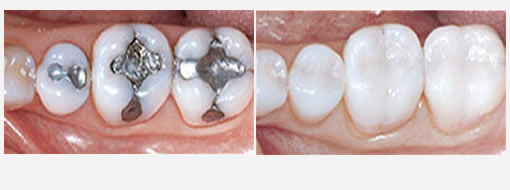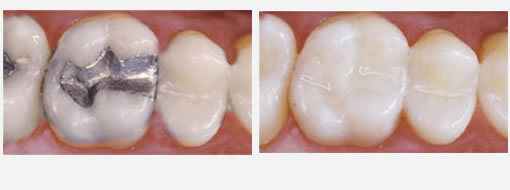
General Dentistry and Fillings at Torgersen Dental, Camarillo & Simi Valley
Fillings are used to treat cavities, restore cracked or broken teeth and protect worn down teeth from misuse (such as from nail biting or tooth grinding).
Steps Involved in Filling a Tooth
Step 1
Dr. Trent and Gina Torgersen will use a local anesthetic to numb the area around the tooth to be filled. Next, a drill, an instrument for air abrasion, or laser is used to remove the decayed area.
Step 2
Dr. Trent and Gina Torgersen will examine or test the area during the process of removing the decay to find out if all the decay has been removed. Once the decay has been eliminated, Dr. Trent and Gina Torgersen will clean the cavity from bacteria and debris in the cavity preparation. If the decay is near the root, Dr. Trent and Gina Torgersen may first put in a liner made of glass ionomer- composite resin, or other material to insulate the nerve. In most cases, after the filling is in, Dr. Trent and Gina Torgersen will finish and polish it.
Various additional steps are involved for tooth-colored fillings:
After Dr. Trent and Gina Torgersen have removed the decay and cleaned the area, the tooth-colored material is applied in layers. Next, a special light that "cures" or hardens each layer is applied. When the multi-layer process is completed, Dr. Trent and Gina Torgersen will build the composite material to the desired result, trim off any unnecessary material, and polish the final restoration.
 Before and After Filling Treatment 1
Before and After Filling Treatment 1Available Types of Filling Materials
Given an understanding of the choices, our experience is that the majority of today’s dental patients choose white fillings, especially considering the controversy surrounding the mercury amalgam ("silver") fillings. Moreover, it seems that the white composite represents a more advanced dental material. In addition to the fact that white composite is more natural looking and esthetic- for all these reasons, the public is strongly asking for "white".
Advantages of White Fillings:
- Composite fillings restore most of the initial strength of the tooth since they bond to them. Silver fillings can weaken the teeth making them more susceptible to breakage. Since broken teeth can be expensive to restore, composite fillings can save in future costs.
- Composite fillings restore the natural appearance of the tooth.
If the restoration is not too deep, teeth restored with white fillings can be less sensitive to hot and cold compared to teeth restored with amalgam. - Composite fillings are mercury-free. Mercury in silver fillings is a controversial subject in dentistry currently.
- Composite fillings require less removal of tooth structure. Especially with new cavities, the size of the hole made for the filling can be considerably smaller with composite fillings.
A few words about other types of filings:
Cast Gold Fillings
Advantages of cast gold fillings:
- Durability – can last 10 to 15 years, sometimes longer doesn't corrode
- Strength – can withstand chewing forces
- Aesthetics "artistic style" – some patients find gold more satisfying to the eye than silver / amalgam fillings
Disadvantages of cast gold fillings:
- Expense – gold cast fillings are up to 10 times higher than the cost of amalgam fillings
- Additional office visits – requires at least 2 office visits to place
- Galvanic shock – a gold filling implanted directly next to a silver (amalgam fillings) can sometimes cause pain from galvanic shock. The interaction between the metals and saliva causes an electric current to occur – however, it's a very rare occasion.
- Aesthetics – most patients prefer "uncolored" fillings
Silver Fillings (Amalgams)
Advantages of silver fillings:
- Durability – silver fillings can last 10 years, sometimes longer
- Strength – can withstand against chewing forces
- Expense – less expensive than composite fillings
Disadvantages of silver fillings:
- Poor aesthetics – silver fillings don't match the color of your natural teeth
- Destruction of more tooth structure – healthy parts of the tooth must be removed frequently to create a space big enough to contain the amalgam
- Discoloration – amalgam fillings can create a grayish hue to the neighboring teeth.
- Cracks and fractures – although all teeth expand and contract with hot and cold liquids, which can ultimately lead to tooth crack or fracture, amalgam material – in comparison with other filling materials – may experience a greater degree of expansion and contraction and lead to a higher occurrence of cracks and fractures
- Allergic reactions – approximately 1% among all people, are allergic to the mercury present in amalgam restorations.
 Before and After Filling Treatment 2
Before and After Filling Treatment 2Other Filling Types
- Ceramics.These fillings are usually made of porcelain, are more resistant to stains than resin composite, but can also be more abrasive. In most cases, this material lasts more than 15 years and can be as expensive as gold.
- Glass ionomer is made of acrylic and a certain type of glass material. This material is most commonly used for fillings below the gum line and filling in young children (drilling is still required). Glass ionomers release fluoride, which may help protect the tooth from further decay. This material is weaker than composite resin and more sensitive to wear and susceptible to fractures. Glass ionomer commonly lasts 5 years or less, cost is comparable to composite resin.
Indirect Fillings
Indirect fillings are similar to composite, tooth–colored, fillings except that they are made in a dental laboratory and require 2 visits before being implanted. Indirect fillings are preferred when not enough tooth structure remains to support a filling, but the tooth is not so severely damaged that it requires a crown.
Decay or an old filling is removed during the 1st visit. An impression is taken to record the shape of the tooth being repaired and the surrounding teeth. The impression is delivered to a dental laboratory that will construct the indirect filling. A temporary filling (described below) is placed to protect the tooth while your restoration is being fabricated. The temporary filling is removed during your 2nd visit and Dr. Trent and Gina Torgersen will examine the fit of the indirect restoration. If the fit is appropriate, it will be cemented and placed permanently.
Two types of indirect fillings: inlays and onlays
- Inlays are similar to fillings where the entire restoration lies within the cusps (bumps) on the chewing surface of the tooth.
- Onlays are larger than inlays, covering one or more cusps. Onlays are also known as partial crowns.
- Inlays and onlays are more durable and last much longer than traditional fillings – up to 30 years. They can be made of tooth–colored composite resin, porcelain, or gold. Inlays and onlays reduce the strength of the tooth structure, but to a much lower extent compared to traditional fillings.
Temporary Fillings and when they are used
Temporary fillings are used when:
- Fillings that require more than one appointment – for example, before placement of gold fillings and for certain filling procedures (called indirect fillings) that use composite materials
- Following a root canal
- Allowing a tooth´s nerve to "settle down" if the pulp became irritated
- If emergency dental treatment is needed (such as to address a tooth ache)
Temporary fillings are just that; they are not meant to last. They usually fall out, fracture, or wear out within 1-2 months. Be sure to contact Dr. Trent and Gina Torgersen to have your temporary filling replaced with a permanent one. If you don't, you could suffer from tooth infection or other complications.
 Before and After Filling Treatment 3
Before and After Filling Treatment 3Call for your appointment today!


